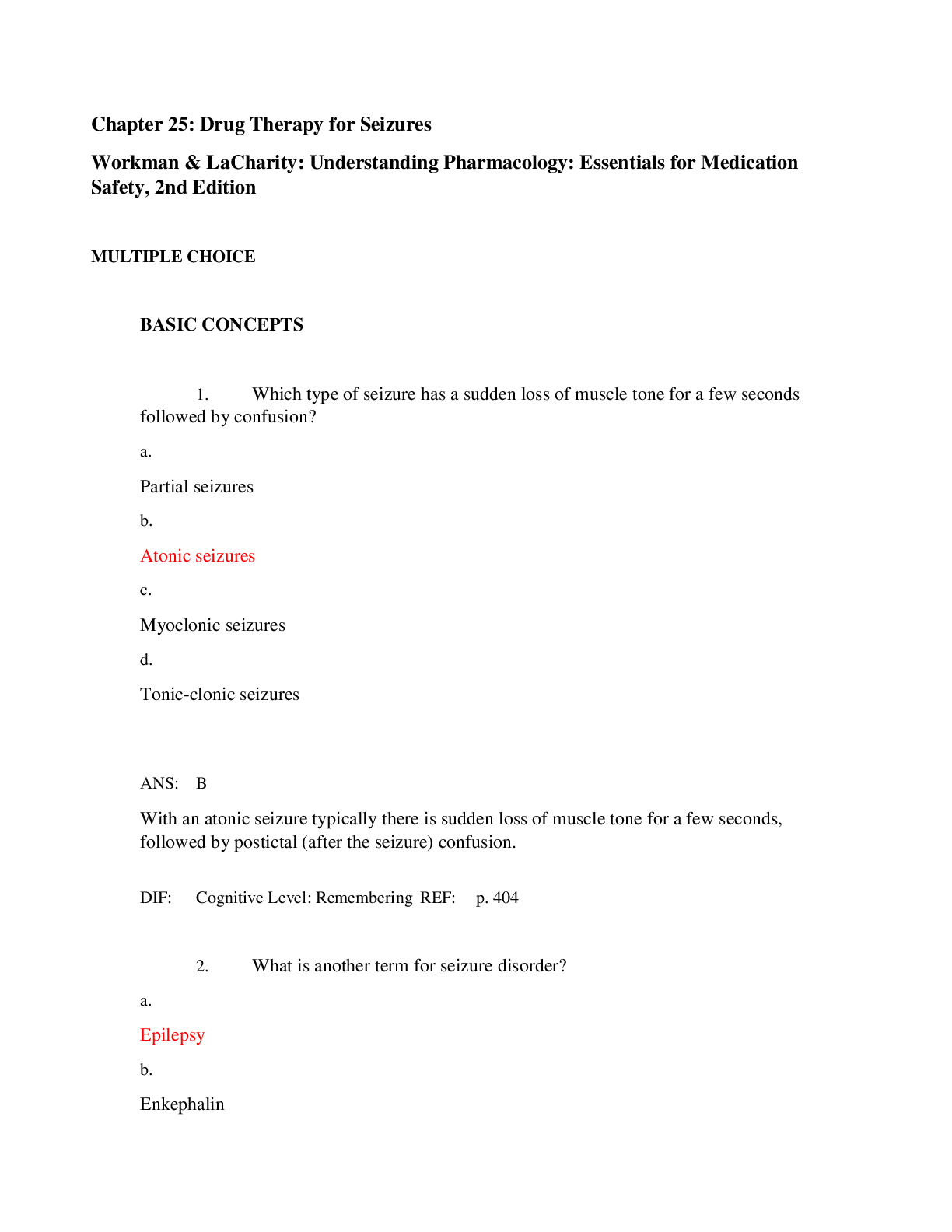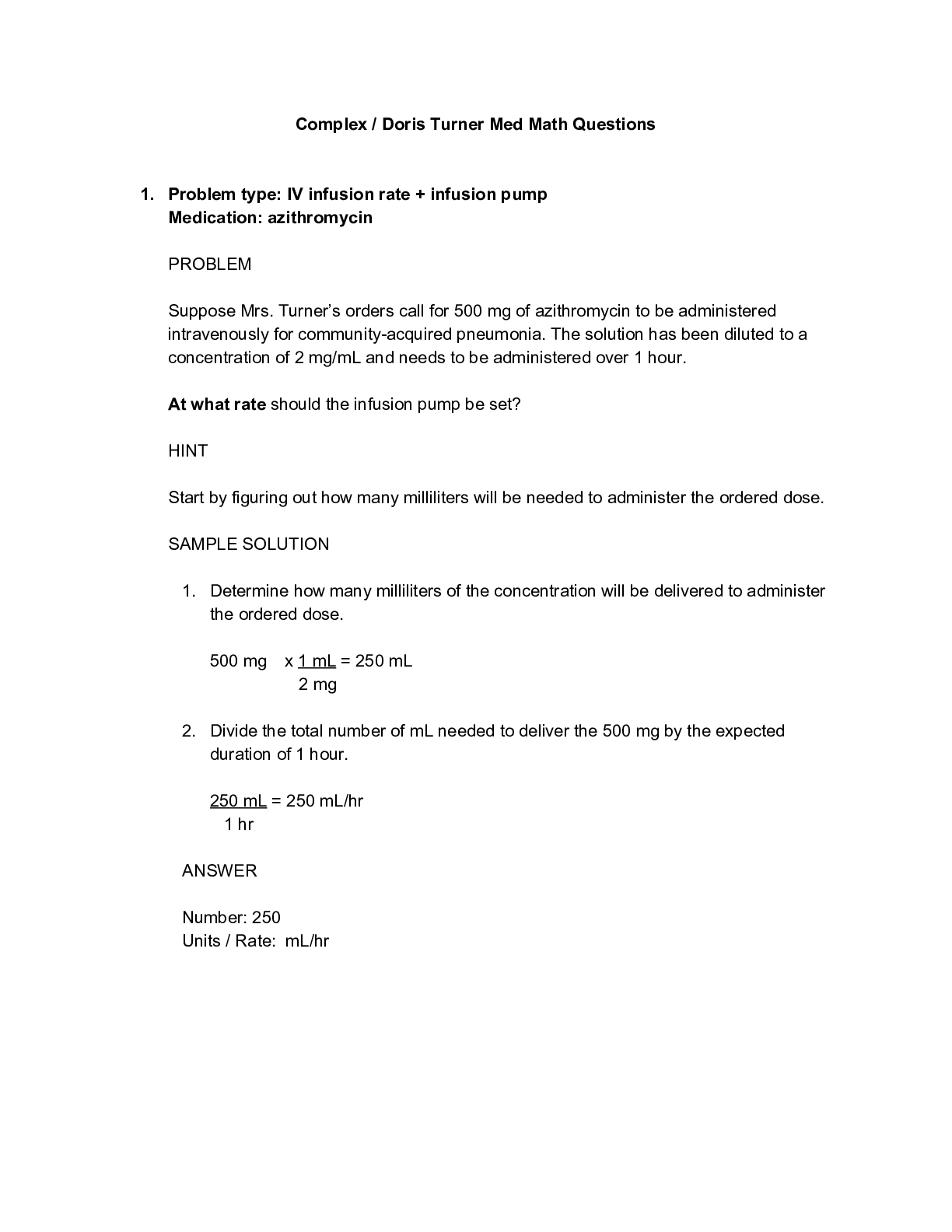Pharmacology > QUESTIONS & ANSWERS > Lincoln - PHARM 101 Chapter 25: Drug Therapy for Seizures: Essentials for Medication Safety, 2nd Edi (All)
Lincoln - PHARM 101 Chapter 25: Drug Therapy for Seizures: Essentials for Medication Safety, 2nd Edition(Q&A) Graded A
Document Content and Description Below
1. Which type of seizure has a sudden loss of muscle tone for a few seconds followed by confusion? a. Partial seizures b. Atonic seizures c. Myoclonic seizures d. Tonic-clonic seizures ANS: ... B With an atonic seizure typically there is sudden loss of muscle tone for a few seconds, followed by postictal (after the seizure) confusion. DIF: Cognitive Level: Remembering REF: p. 404 2. What is another term for seizure disorder? a. Epilepsy b. Enkephalin c. Narcolepsy d. Neuropathy ANS: A An individual with repeated seizures has a seizure disorder, sometimes called epilepsy. DIF: Cognitive Level: Remembering REF: p. 401 3. Which health problem is the most serious possible side effect for status epilepticus? a. Ruptured spinal disks b. Brain tumor c. Broken bones d. Brain damage ANS: D Status epilepticus is a prolonged seizure (usually defined as lasting longer than 30 minutes) or a series of repeated seizures that may occur in almost any type of seizure. Rapid recognition and treatment of this disorder are essential to prevent brain damage. DIF: Cognitive Level: Remembering REF: p. 404 4. Which first-line antiseizure drug can only be given by the oral route? a. Gatifloxacin (Tequin) b. Phenytoin (Dilantin) c. Carbamazepine (Tegretol) d. Valproic acid (Depakote) ANS: C All of these first-line drugs can be given orally and intravenously except carbamazepine. DIF: Cognitive Level: Remembering REF: p. 407 5. Which organs can be badly damaged by valproic acid (Depakote)? a. Eyes and ears b. Skeletal muscles c. Liver and pancreas d. Brain and spinal cord ANS: C Serious adverse effects of valproic acid include damage to the liver (hepatotoxicity) and inflammation of the pancreas (pancreatitis). DIF: Cognitive Level: Remembering REF: p. 408 6. Which side effect of phenytoin (Dilantin) commonly occurs among children taking the drug? a. Delayed bone growth b. Darkening of the eyes c. Thickening of the eyelashes d. Thickening of the gum tissues ANS: D Phenytoin must be used carefully for children because of extra growth of gums while taking the drug. DIF: Cognitive Level: Remembering REF: p. 408 7. Which side effect is most common among people taking first-line drugs for absence seizures? a. Weight loss b. Weight gain c. Low blood pressure d. High blood pressure ANS: A Common side effects of first-line drugs for seizures include the GI symptoms of nausea, vomiting, and indigestion. They may also cause loss of appetite (anorexia) and weight loss. DIF: Cognitive Level: Remembering REF: p. 409 8. Which second-line drug for seizure control has a potential for physical dependence? a. Terbinafine (Lamisil) b. Primidone (Mysoline) c. Lamotrigine (Lamictal) d. Phenobarbital (Luminal) ANS: D Second-line drugs for seizures are alternative drugs for the treatment of seizures. Included in this group are phenobarbital (Luminal) and primidone (Mysoline), which increase the body’s threshold against seizure activity by blocking or slowing the spread of abnormal impulses. The disadvantage of phenobarbital is that it can lead to physical dependence. DIF: Cognitive Level: Remembering REF: p. 410 9. Which two conditions are possible complications of status epilepticus? a. Blurred vision and ringing in the ears b. Muscle paralysis and weakness c. Brain damage and death d. Asthma and wheezing ANS: C Without rapid recognition and treatment, status epilepticus can result in brain damage, coma, and death. DIF: Cognitive Level: Remembering REF: p. 404 10. Which antiseizure drug increases the availability of the neurotransmitter gamma-aminobutyric acid (GABA)? a. Phenobarbital (Luminal) b. Carbamazepine (Tegretol) c. Valproic acid (Depakote) d. Phenytoin (Dilantin) ANS: C The action of valproic acid may be related to increased availability of the neurotransmitter gamma-aminobutyric acid (GABA). [Show More]
Last updated: 2 years ago
Preview 1 out of 28 pages

Buy this document to get the full access instantly
Instant Download Access after purchase
Buy NowInstant download
We Accept:

Reviews( 0 )
$14.50
Can't find what you want? Try our AI powered Search
Document information
Connected school, study & course
About the document
Uploaded On
Oct 24, 2020
Number of pages
28
Written in
Additional information
This document has been written for:
Uploaded
Oct 24, 2020
Downloads
0
Views
110















.png)
.png)
 (1).png)

